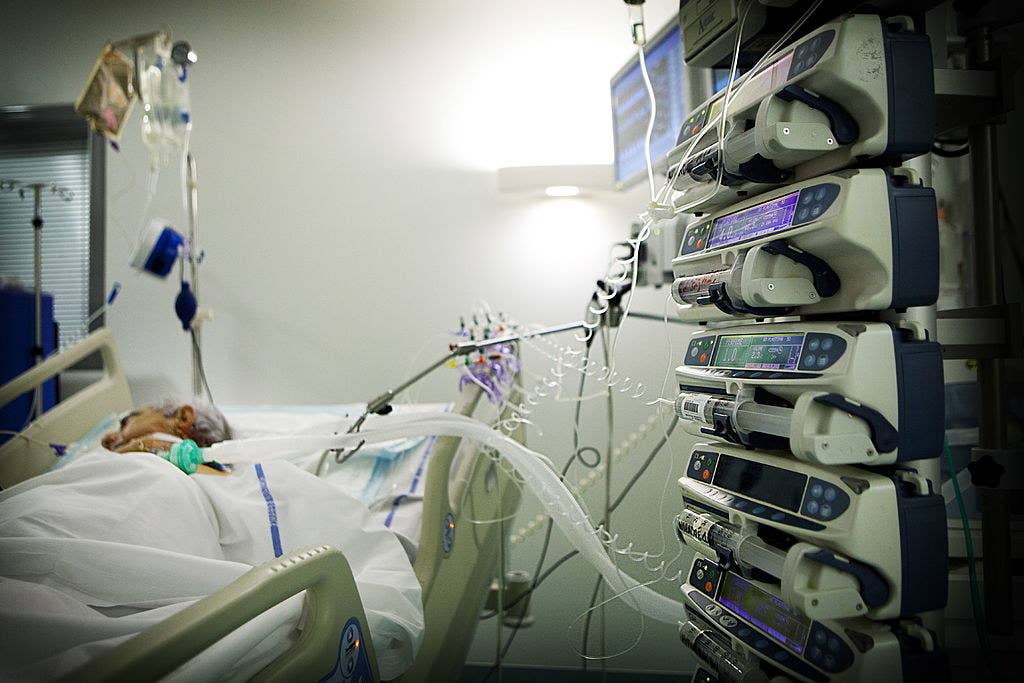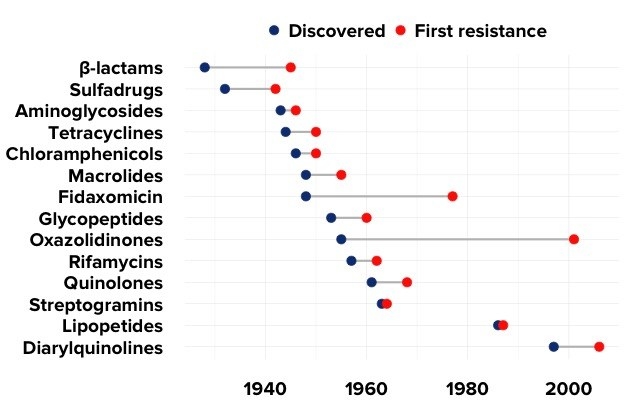
Last week, a 49-year-old woman in Pennsylvania with a urinary tract infection sent shockwaves through the medical establishment. Her illness was caused by E. coli bacteria that failed to respond to several common antibiotics — a common enough problem nowadays. But what really set the alarm bells ringing, when U.S. Army scientists reported on her case, was that these bacteria were also unaffected by colistin, the last line of defense against drug-resistant E. coli and similar superbugs.
Luckily, a few other antibiotics eventually worked against the woman’s infection. But a scary problem remains: The gene responsible for resisting colistin, known as mcr-1, sits on a loop of DNA that can easily move from one bacterium to another. And that means we’re just a few throws of the evolutionary dice away from a genuinely untreatable E. coli superbug.

We don’t have a large arsenal of robust antibiotics because existing drugs have been drastically overused, driving the evolution of resistance. And pharma companies don’t have financial incentives to develop new ones — the margins are too small for companies that are used to measuring their profits in billions. To counter the growing threat, some experts say that antibiotic drugs should be taken off the free market. Instead, their argument goes, the federal government should pay pharma companies upfront to develop new antibiotics, and then control how much they’re sold.
That’s much more like how the Pentagon orders new weapons systems than the current way in which the pharmaceutical industry does business.
“In my opinion, society needs to move towards a defense-contractor model, in part because the economics are very difficult,” said Brad Spellberg, chief medical officer at the Los Angeles County-University of Southern California Medical Center. “I don’t think that the for-profit entrepreneurial pharma model is going to be viable.”
This provocative approach has a precedent in the medical world: To develop drugs and vaccines to protect against bioterrorist attacks, the U.S. government already gives pharma companies hundreds of millions of dollars a year through an agency called the Biomedical Advanced Research and Development Authority, or BARDA. In that case it also puts the drugs in a strategic stockpile — a giant drugs cabinet that would be opened only in the event of an attack. That might not be the best approach to combat drug-resistant bacteria, but experts say the government could instead use financial carrots and sticks to control the antibiotics market.
Spellberg’s views were echoed by Tony Fauci, director of the National Institute of Allergy and Infectious Diseases, who also said that we need to accept that the days of cheap antibiotics may be numbered. If the government is going to invest hundreds of millions of dollars in a drug to combat a specific resistant superbug, he explained, its price will have to be closer to that of today’s targeted cancer therapies in order for pharma to sign on.
That could mean some major rethinking for health insurers, and government programs like Medicare. “If you’re willing to spend tens if not hundreds of thousands of dollars for a drug to that will prolong life in cancer for a couple of months,” said Fauci, “why should you not be willing to spend several thousand dollars to use an antibiotic?”
But the current political climate, in which candidates who rage against Washington’s failures are riding high, is not a great time to float the idea of putting the government in control of an important drug market. And with egregious examples of pharmaceutical price gouging having riled the public and politicians alike, the idea of giving drug companies similar exalted status to defense contractors will be a tough sell.
“Giving pharmaceutical companies money is not popular with a lot of people,” Joe Larsen, acting deputy director of BARDA, told BuzzFeed News.

Still, something needs to change. “We know that we’re running out of drugs,” Gautam Dantas of Washington University in St Louis, who is looking for new ways to use combinations of existing antibiotics without promoting resistance, told BuzzFeed News.
Experts have painted a grim picture of a looming post-antibiotic future: Childbirth and surgery would become a game of Russian roulette, as hospital-acquired infections run amok. Serious burns could carry a death sentence. Catheters, which are notorious breeding grounds for bacteria, could become too dangerous to use. Much of modern medicine, as we have come to know it, would simply cease to exist.
But it doesn’t have to be this way. Biomedical scientists have ideas to counter the scourge of drug resistance, from novel drugs that let bacteria live while disarming the toxins that make some of them so deadly, to antibodies targeted against specific superbugs, to viruses that could fight our bacterial foes.
The big problem is that the conventional economics of the pharmaceutical industry make it hard to turn these ideas into clinical reality. In a 2014 report, the President’s Council of Advisors on Science and Technology (PCAST) laid bare the dismal math: It costs an average of $1.2 billion to push a new drug from the lab bench, through the lengthy clinical trials needed to show that it is safe and effective, and finally into the pharmacy. Drug companies don’t see that investment as worthwhile unless a product rakes in at least $400 million per year for more than a decade.
That’s feasible for drugs against chronic conditions like arthritis, where patients keep coming back for repeat prescriptions year after year. But according to PCAST, providing similar returns for a new therapy against antibiotic-resistant Acinetobacter, a growing cause of hospital-acquired infections, could mean pricing it at more than $20,000 a course. For generations that grew up with family doctors writing antibiotic prescriptions with no thought to the cost, that’s almost inconceivable.
If a drug company manages to bring a new antibiotic to market, its usual goal is to sell as many courses as possible, using it against run-of-the-mill infections rather than keeping it in reserve to fight only the most dangerous superbugs. And that’s exactly the kind of profligate prescribing that has driven the evolution of drug resistance.
“You cannot apply standard for-profit business practices, otherwise you will blow through antibiotics and make them useless very rapidly — which is what has happened,” Spellberg said.
Fighting A Losing Battle

The PCAST report argued that BARDA’s efforts in developing new antibiotics should be expanded beyond potential bioweapons such as plague and anthrax to the wider threat of drug-resistant infections. An additional $400 million a year, PCAST estimated, should be enough to bankroll the development of one new antibiotic every couple of years.
In fact, BARDA is already quietly backing the development of drugs to combat bacterial resistance, including two new antibiotics from Cempra Pharmaceuticals of Chapel Hill, North Carolina — one of which, called solithromycin, is now in the final stages of clinical trials against drug-resistant bacterial pneumonia. And in 2016, BARDA’s budget for antibiotic development more than doubled, reaching $192 million.
So far, however, BARDA has limited its role to subsidizing pharma companies’ clinical trials and toxicity studies. The federal government has not tried to exert control of how the drugs would be used after they are approved for sale. Larsen, BARDA’s deputy chief, told BuzzFeed News that ideas on how to provide incentives to prevent antibiotic overuse are still being worked out.
Depositing the drugs in a government-controlled stockpile, as is done for bioterrorist threats, probably isn’t the best approach for the “slow-moving train wreck” of antibiotic resistance, he said. In the case of a bioterrorist attack, hundreds of thousands of doses could be needed all at once. But stockpiles must be replenished if drugs go past their use-by dates, so it’s a potentially wasteful way to control their use.
So officials are instead debating providing staggered payments to drug companies — running to hundreds of millions of dollars — which would come with strings attached to prevent overuse. “Perhaps you would attach a condition that restricted or eliminated marketing of the drug,” Larsen said. Another idea is to set a volume of sales that, if exceeded, would disqualify a company from receiving further payments.
Not surprisingly, drug companies are wary about controls that could limit their sales. “The last thing in the world I want to do is discover a great new drug and have it sit on the shelf,” Steve Projan, senior vice president for R&D with MedImmune of Gaithersburg, Maryland, told BuzzFeed News. MedImmune, which is part of the drug giant AstraZeneca, is developing two antibodies to combat drug-resistant bacteria that cause pneumonia in intensive-care patients.
Larsen warned that it will also be difficult to muster the political will to provide the government with billions of dollars, over many years, to exert control over the market in antibacterial drugs. But in the meantime, the toll from drug resistance is rising. According to PCAST, antibiotic-resistant bacteria are already killing 23,000 Americans every year.
The stakes are too high to let the pharmaceutical industry call the shots, Spellberg said: “If we want society to have the antibiotics it needs developed, we’re going to have to have a say.”
